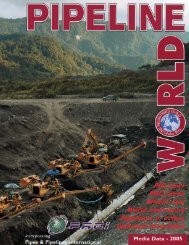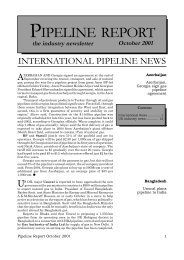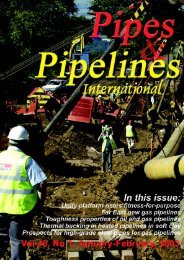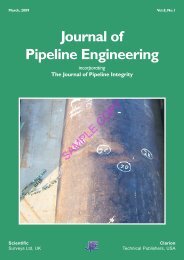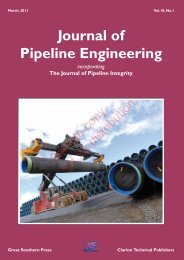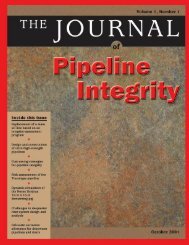JPE - Sept09 - cover2-4.pmd - Pipes & Pipelines International ...
JPE - Sept09 - cover2-4.pmd - Pipes & Pipelines International ...
JPE - Sept09 - cover2-4.pmd - Pipes & Pipelines International ...
You also want an ePaper? Increase the reach of your titles
YUMPU automatically turns print PDFs into web optimized ePapers that Google loves.
164<br />
calibrated by means of the finite-element results. Additional<br />
work is currently being performed to develop equations to<br />
estimate s ref /s M1 . The outcome of these activities, in terms<br />
of equations that can be used to predict M J and/or s ref /s M1<br />
in routine assessments, will be published in 2010.<br />
Plastic strain in ligament<br />
In order to enable an assessment of strains in the ligament<br />
adjacent to embedded flaws, data on strain concentrations<br />
in the smaller of the two ligaments (below and above the<br />
flaw) were obtained for all cases. Figure 12 shows typical<br />
contour plots for the equivalent plastic strain in the ligaments<br />
adjacent to an embedded flaw. The example shown illustrates<br />
contour plots in model E1BH6L50L3M0, which indicate<br />
that strain concentration occurs in two plastic zones<br />
issue<br />
The Journal of Pipeline Engineering<br />
Fig.12. Contour plots for the equivalent plastic strain in the ligaments adjacent to an embedded flaw (model<br />
E1BH6L50L3M0). Sample<br />
extending from the flaw tip towards the surface at 45 o with<br />
respect to the plane of the flaw.<br />
The plastic strain at the surface on either side of the flaw<br />
corresponding to a remote axial strain on the pipe OD of<br />
1% is given in Table 3. It can be seen that such strains,<br />
which increase as the flaw height or length increase or the<br />
ligament decreases, can be as high as 11.5% (model<br />
E1BH9L50L3). It should be noted that these strains were<br />
obtained in models which were perfectly aligned. Had axial<br />
misalignment been included, the strains in the ligament<br />
would have been even higher.<br />
Further research is required to produce guidance on strain<br />
concentrations in the ligament in the presence of axial<br />
misalignment and strength mismatch. Such guidance can



